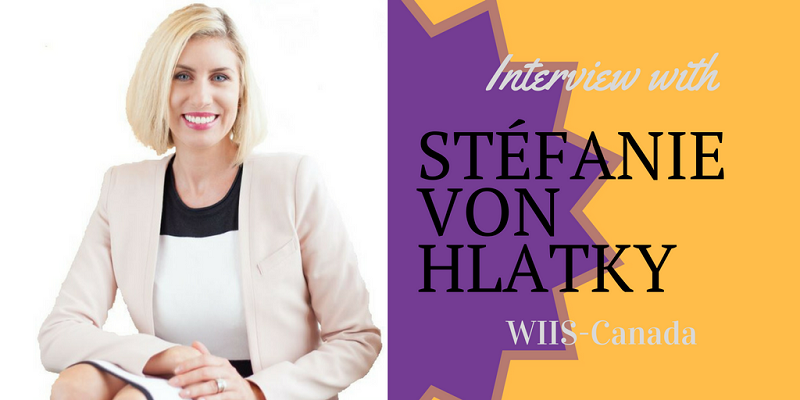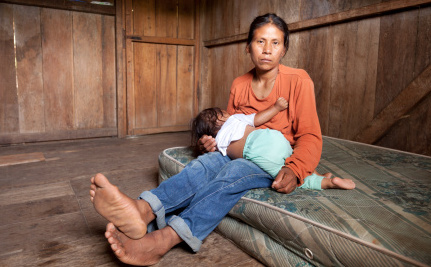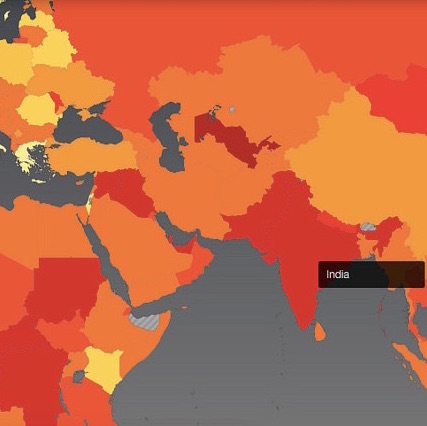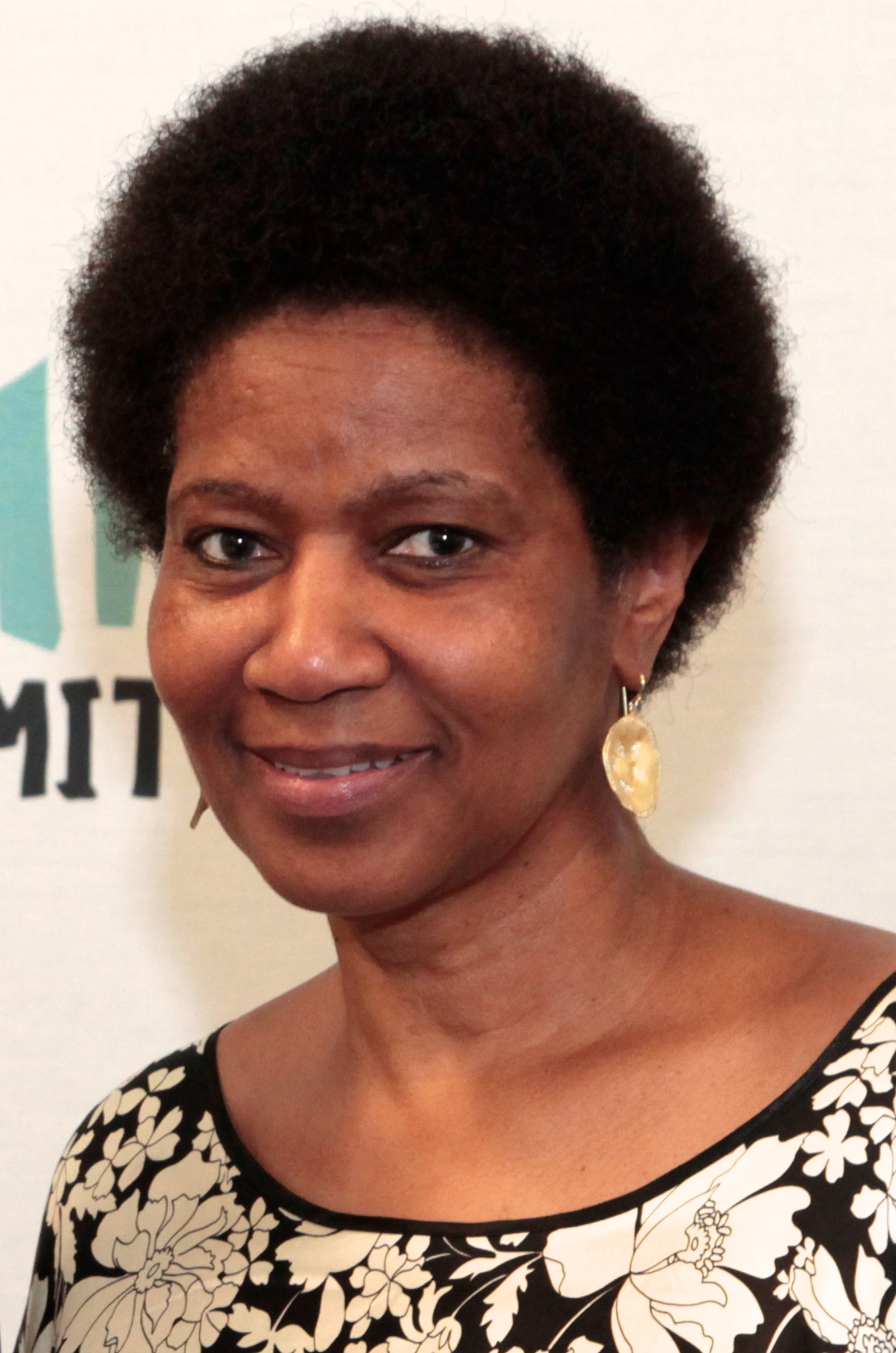Assistant Professor in Political Science at Queens University, and Director of the Queen’s Centre for International and Defence Policy (CIDP), Stefanie von Hlatky is co-founder and Chair of the Board of Women In International Security-Canada (WIIS-Canada), the coordinating organization of the #16days Canadian campaign. Her research interests encompass military cooperation, gender relations in the military, deterrence, and Canada-US relations. She holds a PhD from the Université de Montréal, where she was executive director for the Center for International Peace and Security studies. Amongst many publications and tremendous research, she has recently received NATO Science for Peace and Security grant to design a gender-training course for civilian and military staff members of NATO over the next two years.
As an inspiring female researcher and thriving advocator, Prof. von Hlatky was kind enough to answer some of our questions at NAOC on November 7th 2016. This interview features questions about WIIS-Canada, her role as a female researcher in the effort of gender mainstreaming, gender biases at home, and NATO’s approach to gender. It should not only be an inspiration for young people who wish to pursue a career in academia and/or wish to leverage policy-making environments, but also a perspective to what is being done in the greater effort of gender mainstreaming in the field of Peace and Security.
Here is our interview:
Mégane: As one of the founders of Women In International Security- Canada (WIIS-Canada), can you tell me about what it is and what it represents? What should young professionals, especially young women, know about it?
Prof. von Hlatky: I started Women in International Security Canada after getting to know the American organization. In 2007, WIIS in DC organized a symposium for graduate students, especially female graduate students. They invited about 30 young women to DC to spend a week together. We had research presentations, professional development, coaching, how to negotiate, how to be good public speakers, how to apply for grants and funding opportunities, very “hands on” [activities]. There were also professional networking events. [It thus] combined research, professional skill building, and networking, as core competencies for young graduate female, since, as you know, the field of international security is quite male dominated still.
To me it was the first time that I had been exposed to that hands-on training [which] wasn’t specifically related to academic training. And I loved it. I made such good friends and contacts in the process. On the last day of that symposium I felt really sad (laughing).
I looked into Canada to see if there was a Canadian equivalent, and there wasn’t. There were some women-focused networks but they were not in my field and not really focused on the academic part of it, the academic research, more on the professional networking side.
There were the associations of the Bar for instance –for lawyers and female lawyers– but in the field of international security I didn’t see anything that I could be a part of. So I decided to work with the organization in DC to create an international chapter. We negotiated a Memorandum of Understanding and, in 2008, WIIS Canada was [created]. At the time I was a doctoral student in political science at the Université de Montréal, and I started to talk about this project to faculty members there including Marie Joelle Zahar, and reached out to other women professors like: Prof. Anessa Kimball at Université Laval, and Veronique Kitchen from Waterloo, and Barbara Falk at the Canadian Forces College. As a doctoral student the support of faculty members was crucial to make the organization into something that could survive.
They were really enthusiastic and we decided to organize a workshop similar to the symposium in DC but on a smaller scale. So the 2 day workshop focused on graduate students but broader networking and professional development opportunities as well. The goal, from the get-go, was really to have women from international security [while at the same time having women] from different sectors come together. Students, professional academics –like professors– but also researchers from think tanks, governments, policy makers from governments, members of the armed forces, people from the private sector, civil society organizations, and from international organizations. The network expanded across professional boundaries. And, we also want to provide an opportunity for young and experienced scholars to present their work, to have a privileged platform to showcase the work done by women in international security.
[We had] panel presentations, in which we had more mature scholars and young scholars presenting their work and receiving feedback, we had more targeted skill building panels about grad school application, how do you get your dissertation published into a book, how to prepare for an interview, how to make yourself more aware of gender based biases in your environment. Then, very often, we’d have icebreakers, such as simulation exercises, negotiation exercises, in which people [could] work together on common problems. We also had plenty of networking opportunities: some receptions, and some longer breaks […].
The most valued part of the workshop, I would say, is the mentorship component, the mentorship lunch. Over the course of the workshop we pair each graduate student with a senior-level mentor. Based on the student preferences [established] prior to the workshop, students would tell us if they really wanted to work in government, policy, and DND. Then would find [a] mentor, we bring that mentor to the workshop, and over lunch, in these one on one conversations with the student and their matched mentor, they get to have a one hour long conversation about the field.
So it’s very tailored, very targeted. There’s, on average, 60-80 participants. It can’t be too big because (you) want to leave the workshop feeling you’ve met everyone, and you’ve made meaningful connections with a good number of participants. We’ve been running this workshop for 9 years, the 10th edition of this workshop will be in Montreal, and we’re celebrating [our] 10th year anniversary.
You can imagine, between 60-80 participants in the course of 9 years, we’ve brought together between 500-800 women.
Mégane: Wow that’s impressive.
Prof. von Hlatky: It’s one model among many and it has blossomed into a strong Canadian network of women in international security.
As you can see on our website, whenever we have this event we try to bring policy recommendations, reports, or feature a story so that our members have an idea of what we’re doing.
Mégane: That’s amazing, you do a lot of professional skill building, and a lot of networking. What about advocacy, is it something the organization is working towards?
Prof. von Hlatky: Yes, I would say so. For instance, our 16 days campaign, launching on November 25th, is very much an advocacy campaign against gender-based violence. We have some more targeted exercises and activities which fit under the rubric of advocating. The branch of advocacy that we have [takes the form of] evidence-based recommendations. Everything that we put forward is based on solid research facts.
[For example] we were involved with the defence policy review roundtable – we participated in their gender roundtable. When we come to these meetings we make sure we’re advocating recommendations based on research. Because, we find that a lot of the policies are based on myths regarding female performance, the availability of qualified women, and the physical or intellectual abilities of women. There’s a whole host of gender-based biases. These are still prevalent and that sometimes creates invisible barriers to our participation especially in security and defence. When we do advocacy work, we do it by debunking some of those myths with evidence because we find it’s the most effective approach to get some of the messages across.
Mégane: Those invisible barriers that you talk about, I guess those are the ones that inspired you to create a gender training program, to include men from the civilian and military NATO, but also women and the larger LGBTQ community in the armed forces. You wrote an article for OpenCanada last year in which you talked about a Crisis at home for the Canadian Armed Forces. So, could you tell me a bit more about your program?
Prof. von Hlatky: As an example, I am co-developing a training package for NATO with colleagues from the United States and Australia. The project is funded by the (NATO) Science for Peace and Security grant program and is called “Tailor-made gender awareness operation for the NATO Community”. The goal, really, is to bring a gendered lens to the day to day work of NATO, whether you’re a civilian or from the military, whether you’re working in the Headquarters or in a regional Command.
So, yes it is really relevant for the members of the Armed Forces, if you’re in operations. But it’s also relevant at the front-end, in terms of policy development and operational planning, and for people who have a more HQ-centric role.
The core concept of our gender training approach is that learning to do gender analysis is a core competency now. If you’re a policy maker or if you’re in the operational community, you know how to do risk-based analysis and needs-based analysis, but we haven’t necessarily trained or made people aware of the importance of gender-based analysis so that we can increase the scope of our policy options, so that we can better anticipate the outcomes of our policies. Or, for people in the field, [it is about] better consider[ing] how their presence might be perceived by local communities and population and what kind of partnership they should foster on the ground. Very often, that gender lens is absent from the policymaking process or mission execution.
There [have] been some changes along the way. The military community was good for integrating gender advisers to support commanders on the ground. However if you don’t do this kind of gender-based analysis throughout the process, [if] you just do it in theatre, I think you’re missing a lot of opportunities to have more sophisticated assessment of the situation.
The gender awareness training is really there to say, ok, here is where you conduct gender-based analysis, and we tailor it to each person’s job. So if you’re working as a policy officer at NATO here is how you would apply a gender-based analysis to the problem you’re dealing with. If you’re a commander in the field, well here’s how you would apply the gender-based analysis.
So instead of saying, here are some obligations that NATO has adopted – UNSCR1325– and how you are complying to the resolution, [we’re asking] how have you considered gender as a variable that is important to your current mission? It is an approach more precisely connected with people’s day to day concerns.
Mégane: I’ve heard about this Operation Honour in Canada, and how it’s made. This seems to be more of a classroom education, such that it informs about the obligations, values and principles of the Canadian Military, but not so much about putting people in situations, or having testimonies of victims, or even the conduct of the classroom by people who have a first-hand approach to the problem, is this new gender-training not a classroom type then? It’s more a “mise en situation”.
Prof. von Hlatky: It’s still very much classroom-based [since] you have to teach the content. Even if you’re presenting practical tools for people to be more gender-aware and their day-to-day tasks, it’s very difficult to just give the tools and go.
[Our training project] takes the form of a 3-hour long in-person training. My team and I go to Brussels, where we present a methodology, similar to what I would do at university when I introduce certain theories and methodologies to my students. When it’s introduced as a matter of gender literacy, or in the core of something that they are learning as part of their professional training, you get a lot more openness than when saying: “Well let me tell you about what’s wrong with your military culture.” It will not just solve it.
When it comes to Operation Honour, the CAF has decided to approach gender in a very segmented way. So, sexual violence, sexual harassment, sexual assault, is one “basket”. And it’s very much treated as an HR issue. [Nowadays], they’re recognizing the importance of training. Data is a huge issue when it comes to the CAF [and] knowing how many incidents have happened for years. Underreporting is a known problem, even though some of the reporting structures have been reformed recently.
This [gender] “basket” is treated somewhat differently than from, let’s say, pre-deployment training that would use a gender perspective and introduce 1325. This is very different from the training we would like to see happen in military academies, where gender could be introduced as an analytical lens and approach, with some of the more academic education. Our training with NATO is attempting to bridge those gaps.
We [believe] that this has to be an omnipresent concern. If you really want to mainstream gender, you have to ask questions without necessarily thinking about it. If it’s “mainstreamed”, it comes up naturally. [And] it only comes naturally with practice.
Another important thing is, if you’re going to bring a gender perspective into external operations, if you’re going to be deploying people on the ground for operations and they’re going to be branding 1325 as one of their abiding principles, then there needs to be an assurance that your own house is in order. If you want to speak with any credibility on the international stage about 1325, you [‘d] better make sure that your own Armed Forces, your own government, [are] really up-to-date on what that means for their own organization, that they’re implementing the necessary best practices, and have the knowledge on gender-based analysis, to be able to export it.
[I think it is important to make] that external-internal connection. It’s not done right now in the Canadian context, but I think that, through training –like the training at NATO– you will see more of this comprehensive approach emerge.
Mégane: It sounds like an amazing project. Is [there a possibility for] it to be taken as a model for national training?
Prof. von Hlatky: I think so. I think NATO is the proper model through which to share this information broadly. NATO is composed of 28 different member-states, plus partners. You have representatives from all of these nations in Brussels –the headquarters– who then go back to their capitals, to their own forces back home. So, I think that over the years you [will] get that diffusion effect. Plus, once this course goes through the process of a proper accreditation, and becomes open access/source, everybody [will be able to] resort to it.
[Amongst the] various channels [of training], I have to say [that] the easiest way to get that message across is in person. [And] it’s not about the technology that we have, [however one has to understand that] it’s difficult to teach gender and how gender can be applied to tasks within the security and defence realm without coming up with concrete interactions, without having examples and exercises. Even if you know about gender, you still have your own biases from your own experiences, and you have to be self-reflective and introspective about that. When it is in person, you can really make sure that you have these hooks so that people remember and they know how to work with the approach.
When it’s online, and it’s mandatory, people kind of go through it as quickly as possible to get onto the next stage, right? And, from time to time, we’ve seen that online training approaches don’t really work. There is very low retention of the information presented.
It takes time if you’re doing the in-person approach, and it takes time before that knowledge spreads, but if you have an entry point to institutionalize this by working with military academies, government officials involved in policy directorates, you can then show how the approach can be tailored to their needs.
I think those new practices [will] become part of the conventional [practices]. It’s also very important that they be updated. [I would say that] if data gets better everyday, you can improve year-on with the quality of the analysis you’re offering to practitioners.
Mégane: For this program, how do you plan on reconciling the conceptualization of gender [what gender means] and the inclusion of a wide range of social categories. In other words, how do you go on spreading the message that it is not only an issue between men and women, but that it includes various other variables such as ethnicity, education, economic means and sexual orientation?
Prof. von Hlatky: You have to draw on gender biases and examples [that are relevant to other teaching material], ones that do not only focus on women or teaching “gender”. The data that is available [shows us that] there’s a [significant] level of underreporting from particular demographic groups. The fact that men decide to underreport sexual violence, even more than women do, [shows] that there’s this taboo about it.
[We also learn] from past experiences, for example through the repeal of the “Don’t ask don’t tell policy” and letting transgendered service members be part of the military openly. These changes show that everyone was so scared of the consequences before while [none really] happened. The organization continued to work as effectively as it did before, it didn’t lead to a breakdown at [the level of] unit cohesion.
You can even go back further [in time] while talking about different identifiers. There were similar arguments made against the participation of African-Americans members in the US [military]. Then they were integrated, and of course nothing bad happened. You have all of these examples from the recent past showing the discrimination against different groups of people, [and] their integration was a lot easier than everyone had anticipated. You just have to get that initial hurdle of making the change happen.
I think historical examples are very illuminating but also, more broadly speaking, showing how norms can change. These are just ideas that people hold, and they’re not set in stone. Other norms are here to [be] discuss[ed] just like smoking in public spaces. The attitude that we had a hundred years ago versus the one we have now are completely different. What we consider socially acceptable changes overtime. Drawing on examples not-necessarily from the security and defence realm, seems to resonate.
[It is] also [about] making people a bit more comfortable to discuss these issues, because some people often feel intimidated by discussing gender, or might feel it’s taboo in certain contexts. In some nations, even the word “gender” [makes] people feel uncomfortable.
In those cases, drawing on examples that are not gender-related, or not related to the field of military and defence, will be helpful. You need to reassure people that we’re not singling you out either. [Rather, we should expose] problems that other organizations are grappling with, how they overcome those challenges, and introduce the latest projects that can help [and assist future adaptation/transformation].
The more broadly you can draw on examples, the more helpful it is for people to understand and make all this jargon on gender balancing, gender mainstreaming, gender perspective, and gender incorporation intelligible.
It was a great pleasure to talk with Prof. von Hlatky, and we would like to thank her once again for this insightful interview.
For more information about Stefanie von Hlatky and her projects, check out:
WIIS-Canada’s webpage & Centre for International and Defense Policy/Gender lab website
Photo: Stefanie Von Hlatky by Nichelle Walker. Design on Canva by Mégane Visette
Disclaimer: Any views or opinions expressed in articles are solely those of the authors and do not necessarily represent the views of the NATO Association of Canada.




